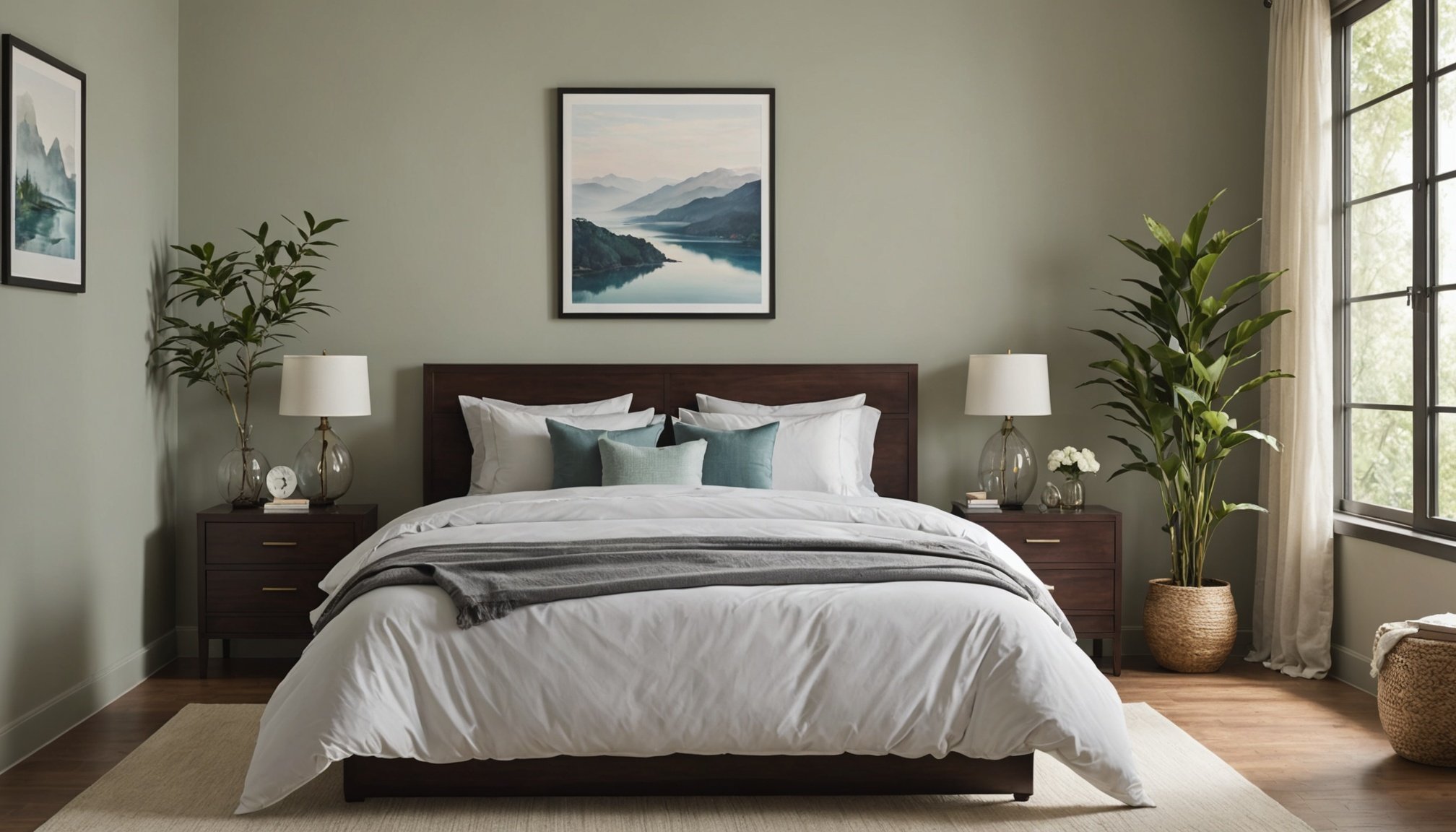Understanding the Concept of a Zen Oasis
A Zen oasis in a home environment is a dedicated space that promotes mindfulness and relaxation. This sanctuary-like area is designed to provide tranquility, helping individuals escape the hustle and bustle of daily life. Mindfulness spaces focus on simplicity and intentional design, emphasizing the importance of a clutter-free setting.
Creating a mindfulness-focused space comes with numerous benefits. It encourages mental clarity and emotional balance, allowing individuals to unwind and center their thoughts. This environment promotes stress reduction, helping people cope with everyday challenges more effectively. Additionally, a peaceful guest room can enhance overall well-being by providing guests with a serene retreat. Visitors can enjoy a space free of distractions, which fosters relaxation and rejuvenation.
Also to read : Designing a Custom Storage Solution for Homemade Artisanal Bread: A Comprehensive Step-by-Step Guide
Incorporating elements such as soft lighting, natural materials, and soothing colors enhances the Zen atmosphere, further promoting mindfulness. The emphasis on creating a sacred space within one’s living quarters aligns with the growing trend of self-care and wellness. Developing a Zen oasis in your home can transform your approach to relaxation, providing a haven that reinforces your overall sense of peace and harmony.
Selecting the Right Color Scheme
Creating a restful ambiance begins with selecting soothing colors that have profound effects on mood. Color psychology plays a crucial role in this process, where colors are associated with specific emotional responses. For a calming guest room, consider using palettes that feature soft blues, gentle greens, and muted earth tones. These hues are known for their ability to evoke tranquility and peace, making them ideal choices for enhancing relaxation.
Also to read : Designing an Elegant and Functional Garden Water Recycling System: The Ultimate Step-by-Step Guide
However, integrating accent colors without overwhelming the space requires careful consideration. Incorporating subtle touches of warmer tones, like soft yellows or blush, can add warmth and balance without disrupting the soothing environment. These colors can be introduced through accessories, such as throw pillows or artwork, to maintain a serene atmosphere.
Understanding how colors impact mood allows homeowners to create a harmonious environment conducive to relaxation. By thoughtfully selecting a color scheme that supports a restful ambiance, it becomes easier to transform any space into a sanctuary of peace. In doing so, you not only improve the aesthetic value of the room but also support the emotional well-being of everyone who enters, contributing to an overall sense of calm and mindfulness.
Furniture and Layout Considerations
Optimizing a Zen oasis begins with selecting purposeful furniture that fosters relaxation. Choose multifunctional and minimalist furniture to maintain simplicity. For example, a sleek sofa bed can double as seating by day and a cozy sleeping spot by night, enhancing versatility without cluttering the room.
When considering room layout, focus on strategies that promote openness and tranquility. Place furniture in a manner that facilitates movement and creates uncluttered pathways. This approach not only enhances space optimization but also contributes to a calming ambiance. Think of arranging seating areas away from high-traffic zones, allowing for a peaceful retreat from daily bustle.
For those eager to infuse mindfulness into their guest space, the layout plays a crucial role. Arrange furnishings to facilitate mindfulness activities such as meditation or yoga. Consider a retractable table that can be tucked away, unfurling an area for relaxation and self-reflection when needed.
Maximize the room’s tranquility by selecting furnishings that resonate with the natural elements such as wood tones. These choices, paired with thoughtful room layout, can significantly enhance relaxation, offering a serene refuge that harmonizes both functionality and aesthetics.
Incorporating Natural Elements
Incorporating indoor plants is an excellent way to enhance tranquility in a guest room. They naturally improve air quality, creating a healthier environment and facilitating relaxation. Opt for plants like peace lilies or snake plants, which are low-maintenance and thrive indoors. These choices not only add a visual element of calmness but also support biophilic design.
Using natural materials such as wood and stone can further strengthen the connection to nature within the space. Wooden furniture or stone accents provide a grounding effect, adding texture and warmth. Emphasizing these elements creates a serene atmosphere that echoes the tranquility of the great outdoors.
Biophilic design principles integrate nature into our living spaces, enhancing the guest experience. Consider incorporating a water feature or using wallpaper with nature-inspired motifs to invoke feelings of peace. By bringing these elements into the room, guests can enjoy a harmonious setting that supports mindfulness and rejuvenation.
This approach not only beautifies the space but makes it a true Zen oasis, blending the internal environment with elements inspired by nature. Cultivating this blend of natural elements can play a significant role in promoting relaxation.
The Role of Textiles and Comfort
Elevating your guest room into a sanctuary of comfort starts with selecting the right textiles. Opt for comfortable textiles that add both style and cosiness to the space. Materials like soft cotton, cashmere, or linen are ideal for crafting an inviting environment. When layering fabrics, consider incorporating textures such as knit throws or plush rugs. This enhances sensory comfort and adds a touch of visual interest.
Bedding Choices
Choosing high-quality bedding is crucial for ensuring restful sleep. Look for sheets with a high thread count and natural fibres for breathability. A supportive mattress topper further enhances sleep quality, offering guests a refreshing night’s sleep. Bedding sets that include a variety of pillows, in terms of firmness, accommodate different sleep preferences and add extra comfort.
Creating a layered textile approach not only makes the room cosy but also stylish. Mix and match different textiles to design an aesthetically pleasing setting. A thoughtful combination of materials reinforces a sense of luxury and relaxation. By focusing on textiles and comfort, you transform your guest space into a true Zen oasis that promotes rest and rejuvenation.
Aromatherapy and Scents
Infusing your guest room with aromatherapy is an effective way to enhance relaxation and mindfulness. Calming scents such as lavender, chamomile, and sandalwood are known for their soothing properties, helping to create a serene environment. Lavender, for example, is known to reduce stress and promote better sleep, making it ideal for a restful guest experience.
Integrating essential oils can be done in various ways to maximize their calming effects. Consider using a diffuser to disperse these fragrances gently throughout the room. This not only enhances the air quality but also provides a continuous sense of calmness. For a more intimate scent experience, adding a few drops of oil to a warm bath or applying to pulse points can be beneficial.
Products such as diffusers, scented candles, and room sprays are excellent tools in creating a tranquil setting. Opt for naturally derived fragrances to maintain a clean and health-conscious atmosphere. Incorporating these elements ensures your guest room becomes a fragrant haven, promoting relaxation and allowing guests to indulge in a truly peaceful retreat. Essential oils, when used correctly, can elevate the art of relaxation into a holistic experience.
Enhancing Soundscapes
Creating a serene environment in a Zen oasis involves more than visual aesthetics; sound plays a pivotal role. Relaxing sounds can significantly enhance relaxation and focus, making them essential in any mindful space. Utilizing sound machines or curated playlists featuring nature sounds, such as gentle rain or ocean waves, enriches the meditative quality of a room, promoting tranquility. These auditory elements complement the calming visuals of your interior, creating a truly immersive sanctuary.
Investing in a high-quality sound machine can transform the atmosphere by masking disruptive noises with ambient soundscapes. Choose a model with diverse sound options to tailor the environment to each guest’s preference. Furthermore, integrating soundproofing techniques—such as thick drapes or acoustic panels—helps muffle outside noise, maintaining the peaceful aura of the space.
To enhance mindfulness practices, encourage guests to explore playlists designed specifically for relaxation. Applications like Spotify offer extensive collections of soothing music that align with mindfulness goals. By orchestrating a quiet ambiance, the room becomes a haven where all senses are attended to, fostering a deeper relaxation experience. This attention to soundscapes underscores the holistic nature of designing spaces dedicated to both peace and mindfulness.
Mindfulness Practices for Guests
Enhancing the serenity of a guest’s stay can be achieved by introducing simple mindfulness techniques that encourage relaxation and presence. Providing guests with opportunities to connect with themselves in a tranquil setting deepens their experience and fosters a sense of tranquility.
Integrate relaxation methods such as guided meditation or gentle yoga sessions into their stay. A thoughtfully created guide highlighting breathing exercises, progressive muscle relaxation, and meditative walks can inspire them to explore at their own pace. These activities encourage mindfulness, helping guests to unwind and embrace the peaceful environment around them.
For guest engagement, it’s beneficial to offer resources that vary in accessibility and interest. Include a selection of books or magazines that focus on mindfulness practices and relaxation techniques. Consider offering tools like meditation apps or portable sound baths, which guests can use during their stay or take home for continued practice.
Providing guests with these mindfulness techniques not only enriches their experience but aligns with the core concept of a Zen oasis. Encouraging these practices can promote relaxation, leaving guests feeling refreshed and rejuvenated, contributing positively to their overall sense of well-being.





